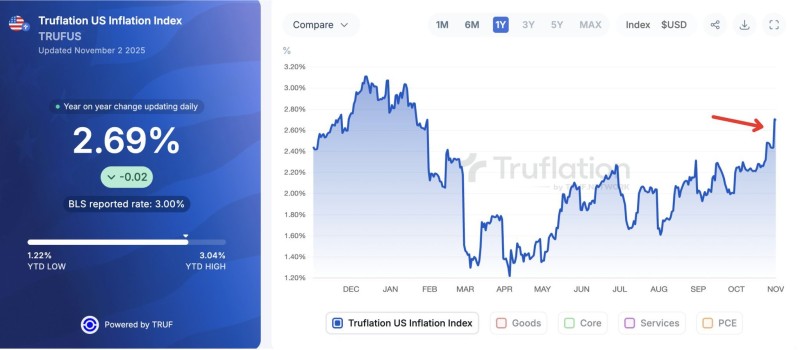The Truflation U.S. Inflation Index, which tracks consumer price trends in real time, has climbed to 2.69% as of November 2, 2025. This marks a significant rebound from earlier lows and suggests that inflationary pressures are building again across the American economy. While still below the official Bureau of Labor Statistics figure of 3.00%, the upward momentum is becoming harder to ignore.
The data reveals a sharp recovery from June's near-2.0% reading, with prices now approaching the year-to-date peak of 3.04%. After months of volatility, the trend has turned decisively upward heading into the fourth quarter.
Truflation Index Shows Strong Recovery
According to analysis from DustyBC Crypto, the index bottomed out around 1.2% back in March before staging a steady recovery through the summer and fall months. The recent acceleration toward 2.7% points to renewed pressure in consumer prices, especially within services and energy.

The chart pattern tells a clear story. Inflation has been climbing consistently since April, forming higher lows month after month. The psychological 3.0% level has become a key resistance point that markets and policymakers are watching closely. While goods prices have remained relatively stable, rising costs in the service sector have been the primary driver of the overall increase. This sustained momentum reflects stronger consumer demand and wage growth that continues to push against the Fed's 2% target.
What's Behind the Rebound?
Several factors have converged to push inflation higher in recent months:
- Energy and commodity prices have bounced back since late summer, affecting transportation and food costs
- Persistent wage growth in tight labor markets continues fueling service-sector inflation
- Supply chain issues haven't fully resolved, with shipping costs and logistics disruptions adding to input prices
- Consumer spending has remained resilient despite higher interest rates
These developments suggest that the disinflationary trend may have stalled, at least for now, as cyclical forces reassert themselves.
Fed Policy and Market Implications
This uptick toward 2.7% creates a tricky situation for the Federal Reserve. Markets had been anticipating possible rate cuts in early 2026, but inflation staying above target could force policymakers to hold rates higher for longer. Bond yields have remained elevated in response, though equity markets have held up relatively well on expectations of continued economic growth. If the index keeps pushing toward 3%, investors will likely need to rethink their assumptions about when and how aggressively the Fed might ease policy.
 Peter Smith
Peter Smith

 Peter Smith
Peter Smith
